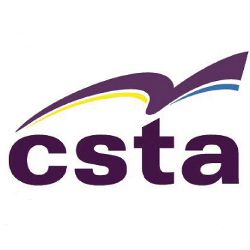
It is truly a great time to be in CS education, and yet CS educational needs in K–12 are greater today than ever before. A lack of access to CS among a range of demographics, including Hispanic, female, and lower-income students continues to persist. According to respondents to a recent Google and Gallup study, fewer than half of the students in these demographic groups identify any exposure to CS in school and only 1 in 4 responding schools reported having someone to teach CS. The research found general confusion as to what CS is among students, parents, and educators, with stereotypes existing at many levels.
Add to this mix a dedicated cadre of CS teachers. The 8th-grade music teacher, for instance, teaching CS for the first time this year and trying to learn where to start. The high school Spanish teacher, who is so passionate about CS, that to introduce CS into her school, she teaches CS in Spanish. The high school math teacher who has taught CS in his school for years, but lacks the confidence in his own CS skills to make substantive changes to the projects and programs he uses in class. These are but three examples of real CS teachers who are among the faces of K–12 CS education today.
Enter the Computer Science Teachers Association (CSTA). Founded by ACM just over a decade ago, CSTA now has more than 22,000 members across 130 countries. This includes more than 60 local member chapters in North America, and three international affiliates (U.K., Israel, and New Zealand). The support of ACM and its members enables CSTA to fulfill its mission.
So what is CSTA doing or have planned? Building on our strengths and listening to the needs of the K–12 CS teacher community, we will grow our capacity and programs in five interrelated areas: operations, diversity, professional development, research, and awareness.
Operations: In the coming weeks the first phase of our new website and a new association management system will go live. These establish a foundation to support improved communication, data analytics, communities of practice, grassroots advocacy, and other engagement initiatives. These are enhancements many of us look forward to seeing implemented, as they will increase our ability to support and engage our members.
Diversity: Many groups are addressing diversity in CS, but much more needs to be done. CSTA’s unique contribution will be the Diversity Educational Leadership Program (DELP). DELP will seek to identify the mentoring, professional development, and support needs of teachers from underrepresented backgrounds or working with students from underrepresented groups. We will then work with others in this space to help meet those needs. The goal is to help these teachers be more successful, and enable them to become teacher leaders or advocates for CS education within their classrooms, communities, and school districts.
Professional Development (PD): CSTA remains committed to the K–12 CS teaching standards. We also plan to raise the bar on current PD offerings, such as the annual conference, and explore new PD opportunities, such as online programs, webinars, and increased PD resources for chapters and international members.
Research: Building on CSTA’s existing research experience, we plan to continue to pursue research that can generate direct outcomes for the K–12 CS teacher. Sample research topics on our priority list include work related to learning assessment, pedagogy, diversity, understanding different groups of teachers (for example, new CS teachers), and innovative approaches to teacher PD.
Awareness: We will engage in more strategic outreach to the media and potential partner organizations, so that we may build awareness and diversify support for CSTA programs, and educate other groups on the nature and diversity of CS, both in terms of careers and skills. This includes promoting opportunities such as the Cutler-Bell Award, the NSA Day of Cyber, the Congressional App Challenge, the Allen Distinguished Educators Awards, the Faces of Computing Competition, and programs with partners, such as Google, College Board, Oracle Academy, and Pluralsight, among others.
Yes, it is a great time to be involved with K–12 CS education. CS is emerging as the lingua franca of the evolving world. As Jane Margolis argues in her research, access to this universal language is fundamental to future prosperity and participation in society. Computational technology is increasingly ubiquitous, and will continue to accelerate the pace of knowledge creation and societal change across the globe. Helping teachers helps students. CSTA looks forward to continued collaboration with ACM staff, volunteers, and partners as we work to support, empower, and grow the K–12 CS teacher community.



Join the Discussion (0)
Become a Member or Sign In to Post a Comment